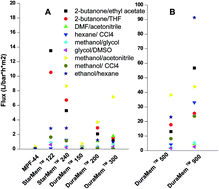Separation of binary solvent mixtures with solvent resistant nanofiltration membranes Part A: investigation of separation performance
Abstract
This paper is Part A of a two paper series seeking a systematical investigation of the feasibility of separating binary solvent mixtures with solvent resistant nanofiltration (SRNF) membranes. A series of binary solvent mixtures with different physical and chemical properties (dielectric constant, surface tension, Hansen solubility parameter and viscosity) was chosen, and single factor analysis was performed to tap the potential of solvent separation using different commercial SRNF membranes (MPF™ series, StarMem™ series, DuraMem™ Series). It was found that the DuraMem™ 150 allowed the separation of ethanol–1-hexane mixtures with a separation factor of around 6, which is the highest for solvent separation in SRNF so far. The presence of preferential permeation was found to be mainly dependent on the membrane structure, differences in the Hansen solubility parameter and polarity between the solvents and membrane. Some important hypotheses including that dense SRNF membranes were more likely to separate binary solvent mixtures, that separation process followed the typical solution–diffusion mechanism, and that the Hansen solubility parameters and polarity of membranes and solvents were main factors affecting the separation were proposed for the first time.


 Please wait while we load your content...
Please wait while we load your content...